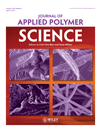Preparation and properties of biocomposites composed of epoxidized soybean oil, tannic acid, and microfibrillated cellulose
Abstract
As a new biobased epoxy resin system, epoxidized soybean oil (ESO) was cured with tannic acid (TA) under various conditions. When the curing conditions were optimized for the improvement of the thermal and mechanical properties, the most balanced properties were obtained when the system was cured at 210°C for 2 h at an epoxy/hydroxyl ratio of 1.0/1.4. The tensile strength and modulus and tan δ peak temperature measured by dynamic mechanical analysis for the ESO–TA cured under the optimized condition were 15.1 MPa, 458 MPa, and 58°C, respectively. Next, we prepared biocomposites of ESO, TA, and microfibrillated cellulose (MFC) with MFC contents from 5 to 11 wt % by mixing an ethanol solution of ESO and TA with MFC and subsequently drying and curing the composites under the optimized conditions. The ESO–TA–MFC composites showed the highest tan δ peak temperature (61°C) and tensile strength (26.3 MPa) at an MFC content of 9 wt %. The tensile modulus of the composites increased with increasing MFC content and reached 1.33 GPa at an MFC content of 11 wt %. Scanning electron microscopy observation revealed that MFC was homogeneously distributed in the matrix for the composite with an MFC content of 9 wt %, whereas some aggregated MFC was observed in the composite with 11 wt % MFC. © 2010 Wiley Periodicals, Inc. J Appl Polym Sci, 2011




